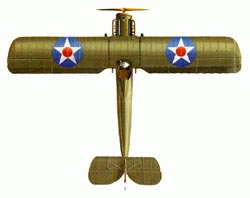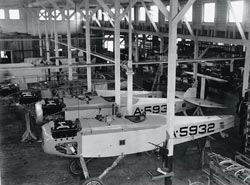|
 When Chance M. Vought started pursuing his company’s first Army contract, he already had the idea for an airplane that would surpass the Wright-Martin V, the VE-7 Bluebird. It was here that Chance Vought’s engineering genius became visible. Barely 91 days after he secured the contract, he delivered the first VE-7 Bluebird to the government for test on February 11, 1918. When Chance M. Vought started pursuing his company’s first Army contract, he already had the idea for an airplane that would surpass the Wright-Martin V, the VE-7 Bluebird. It was here that Chance Vought’s engineering genius became visible. Barely 91 days after he secured the contract, he delivered the first VE-7 Bluebird to the government for test on February 11, 1918.
By contrast, Vought’s latter jets (i.e., F8/A7) took about 4 years from company contract to military initial operational capability (IOC). However, today’s more complex jets (i.e., F22) are anticipated to reach IOC about 14/15 years from contract initiation.
 Production methods were expedient, with component sections like the fuselage and wings completed in the loft, lowered by rope and pulley through a removable window and assembled on the street below. After the Hispano Suiza 150-hp engine was installed, it was run up with the airplane’s tail tied to a telephone pole. Next, it was trucked 25 miles to Hazelhurst Field to enter an Army Signal Corps competition against some large American companies for a contract. The contract was to build an advanced trainer to replace Curtiss Jennies, Standard, Thomas-Morse and other aircraft. The little biplane, with the words “Aeroplanes Vought” painted on its tail, was Vought’s hopeful offering in the direction of a military contract. Production methods were expedient, with component sections like the fuselage and wings completed in the loft, lowered by rope and pulley through a removable window and assembled on the street below. After the Hispano Suiza 150-hp engine was installed, it was run up with the airplane’s tail tied to a telephone pole. Next, it was trucked 25 miles to Hazelhurst Field to enter an Army Signal Corps competition against some large American companies for a contract. The contract was to build an advanced trainer to replace Curtiss Jennies, Standard, Thomas-Morse and other aircraft. The little biplane, with the words “Aeroplanes Vought” painted on its tail, was Vought’s hopeful offering in the direction of a military contract.
More about the VE-7:
The Aircraft That Got a Company off the Ground
VE-7 Production
Additional VE-7s
VE-7 as a History Maker
|

 When Chance M. Vought started pursuing his company’s first Army contract, he already had the idea for an airplane that would surpass the Wright-Martin V, the VE-7 Bluebird. It was here that Chance Vought’s engineering genius became visible. Barely 91 days after he secured the contract, he delivered the first VE-7 Bluebird to the government for test on February 11, 1918.
When Chance M. Vought started pursuing his company’s first Army contract, he already had the idea for an airplane that would surpass the Wright-Martin V, the VE-7 Bluebird. It was here that Chance Vought’s engineering genius became visible. Barely 91 days after he secured the contract, he delivered the first VE-7 Bluebird to the government for test on February 11, 1918.
 Production methods were expedient, with component sections like the fuselage and wings completed in the loft, lowered by rope and pulley through a removable window and assembled on the street below. After the Hispano Suiza 150-hp engine was installed, it was run up with the airplane’s tail tied to a telephone pole. Next, it was trucked 25 miles to Hazelhurst Field to enter an Army Signal Corps competition against some large American companies for a contract. The contract was to build an advanced trainer to replace Curtiss Jennies, Standard, Thomas-Morse and other aircraft. The little biplane, with the words “Aeroplanes Vought” painted on its tail, was Vought’s hopeful offering in the direction of a military contract.
Production methods were expedient, with component sections like the fuselage and wings completed in the loft, lowered by rope and pulley through a removable window and assembled on the street below. After the Hispano Suiza 150-hp engine was installed, it was run up with the airplane’s tail tied to a telephone pole. Next, it was trucked 25 miles to Hazelhurst Field to enter an Army Signal Corps competition against some large American companies for a contract. The contract was to build an advanced trainer to replace Curtiss Jennies, Standard, Thomas-Morse and other aircraft. The little biplane, with the words “Aeroplanes Vought” painted on its tail, was Vought’s hopeful offering in the direction of a military contract.